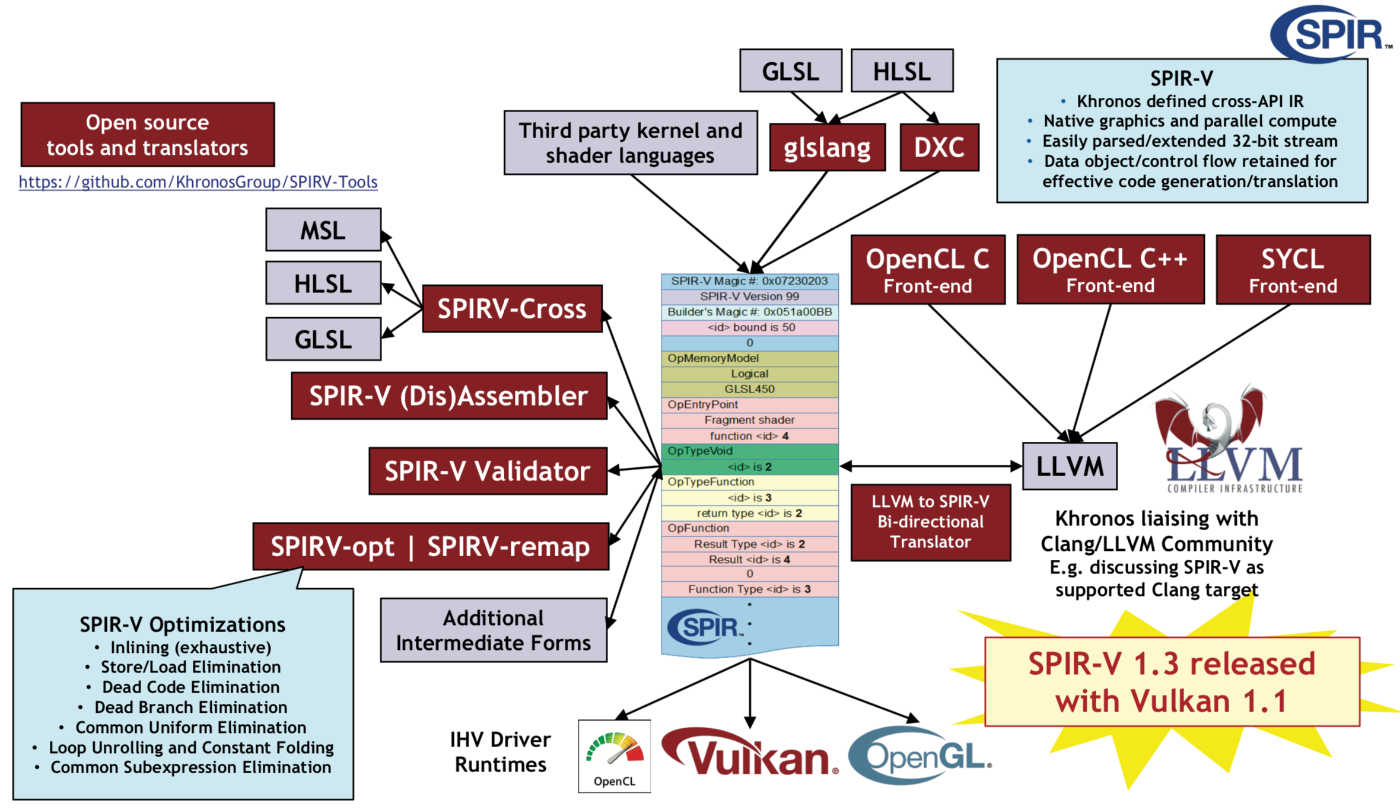
Khronos.org Vulkan 1.1
Kotlin Wrapper for Vulkan
Vulkan Kotlin examples and demos
kotlin-graphics
Examples and demos for the new Vulkan API
jvm gli
Vulkan Android 7.0 adds support for Vulkan
Getting Started with Vulkan on Android
Vulkan Graphics API
Support for Vulkan Graphics API 1.1 is coming in Android P
Swift package for Vulkan
Vulkan + Swift: Linking the Vulkan SDK using Swift Package Manager
Open-Source Vulkan C++ API
Khronos News

MoltenVK 0.16.0 Demo Projects
Apple Metal 2
MoltenVK is an implementation of the high-performance, industry-standard Vulkan graphics and compute API, that runs on Apple’s Metal graphics framework, bringing Vulkan to iOS and macOS.
Apple объяснила отказ от OpenGL
Vulkan — кроссплатформенный API для 2D- и 3D-графики, впервые представленный Khronos Group в рамках конференции GDC 2015. Vulkan API изначально был известен как «новое поколение OpenGL»
Youtube vulkan api
Краткий курс компьютерной графики

The Khronos Group
Khronos royalty-free open standards for 3D graphics, Virtual and Augmented Reality, Parallel Computing, Neural Networks, and Vision Processing
Oxford Deep NLP 2017 course
A Stable Neural-Turing-Machine (NTM) Implementation (Source Code and Pre-Print)
A series of models applying memory augmented neural networks to machine translation
Runtime 3D Asset Delivery
Sketchfab
Facebook получила поддержку 3D-файлов формата glTF 2.0 и новые способы распространения 3D-контента
glTF 2.0 и OpenGEX
glTF-Sample-Models
glTF Tutorial This tutorial gives an introduction to glTF, the GL transmission format. It summarizes the most important features and application cases of glTF, and describes the structure of the files that are related to glTF. It explains how glTF assets may be read, processed, and used to display 3D graphics efficiently.
glTF-CSharp-Loader
glTF – Runtime 3D Asset Delivery
glTF™ (GL Transmission Format) is a royalty-free specification for the efficient transmission and loading of 3D scenes and models by applications. glTF minimizes both the size of 3D assets, and the runtime processing needed to unpack and use those assets. glTF defines an extensible, common publishing format for 3D content tools and services that streamlines authoring workflows and enables interoperable use of content across the industry.
Runtime GLTF Loader for Unity3D
glTF-Blender-IO

SYCL C++ Single-source Heterogeneous Programming for OpenCL
Khronos SYCL Registry
SyclParallelSTL Open Source Parallel STL implementation
SYCL
SYCL WiKi
TensorFlow™ AMD Setup Guide
TensorFlow 1.x On Ubuntu 16.04 LTS
AMDGPU-PRO Driver for Linux

Codeplay Announces World’s First Fully-Conformant SYCL 1.2.1 Solution Posted on August 23, 2018

SPIR The Industry Open Standard Intermediate Language for Parallel Compute and Graphics
SPIRV-Cross is a practical tool and library for performing reflection on SPIR-V and disassembling SPIR-V back to high level languages
A short OpenGL / SPIRV example
Khronos Vulkan
Vulkan NVIDIA
Eigen is a C++ template library for linear algebra: matrices, vectors, numerical solvers, and related algorithms.
An implementation of BLAS using the SYCL open standard for acceleration on OpenCL devices
Tensorflow
ComputeCpp is Conformant with SYCL 1.2.1!
triSYCL
Xilinx FPGAs: The Chip Behind Alibaba
Optimizing the Convolution Operation to Accelerate Deep Neural Networks on FPGA

Neural Network Exchange Format
Neural Network Exchange Format (NNEF)
The NNEF Tools repository contains tools to generate and consume NNEF documents

The LLVM Compiler Infrastructure
Getting Started with the LLVM System
LLVM Download Page
Clang: a C language family frontend for LLVM
LLVM 8.0.0 Release Notes
Clang 7 documentation
Clang (произносится «клэнг») является фронтендом для языков программирования C, C++, Objective-C, Objective-C++ и OpenCL C, использующимся совместно с фреймворком LLVM. Clang транслирует исходные коды в байт-код LLVM, затем фреймворк производит оптимизации и кодогенерацию. Целью проекта является создание замены GNU Compiler Collection (GCC). Разработка ведётся согласно концепции open source в рамках проекта LLVM. В проекте участвуют работники нескольких корпораций, в том числе Google и Apple. Исходный код доступен на условиях BSD-подобной лицензии.
Clang. Часть 1: введение
Как приручить дракона. Краткий пример на clang-c
clang и IDE
Clang API. Начало
Support for Vulkan Graphics API 1.1 is coming in Android P
The Vulkan API is widely regarded as the successor to OpenGL. Initially announced in 2015, the Vulkan Graphics API has provided significant improvements in graphics rendering performance compared to its predecessor. Support for the graphics API made its way over to Android after its initial announcement with the first release of Android 7.0 Nougat, giving a much-needed boost to mobile gaming. Recently, a new revision of the graphics API was released, so the next logical step for Google is to integrate it into their next version of Android. And indeed, support for Vulkan 1.1 is going to be included with Android P, the next major version of Android, according to recent commits in the Android Open Source Project (AOSP) gerrit.
Some of the highly anticipated features included within the 1.1 release of the Vulkan API include Subgroup Operations, extension integration, SPIR-V 1.3, and more. The commits integrating Vulkan API 1.1 have already been merged, meaning the revision will be available presumably in the second developer preview of Android P and, eventually, with the final, stable version. End users won’t really be able to see the benefit from these changes—after all, it’s not really a groundbreaking revision of the Vulkan API, but rather it redefines and improves key parts of it. Mobile games currently using Vulkan as their backend should still work and behave the same as with 1.0, and nothing will suddenly break or start working better/faster. But Android game developers should benefit a lot from the developer-oriented changes in v1.1 of the API, so users running Android P will eventually start to reap those benefits once developers start integrating the API’s new features.
Developers wanting to take advantage and play around with version 1.1 should wait until the second developer preview of Android P drops for the Google Pixel and Pixel 2 devices. As Vulkan 1.1 expands some of the core capabilities of the graphics API, there’s a lot to be excited about if you’re a game developer, so keep an eye out for future changes in Android P.






